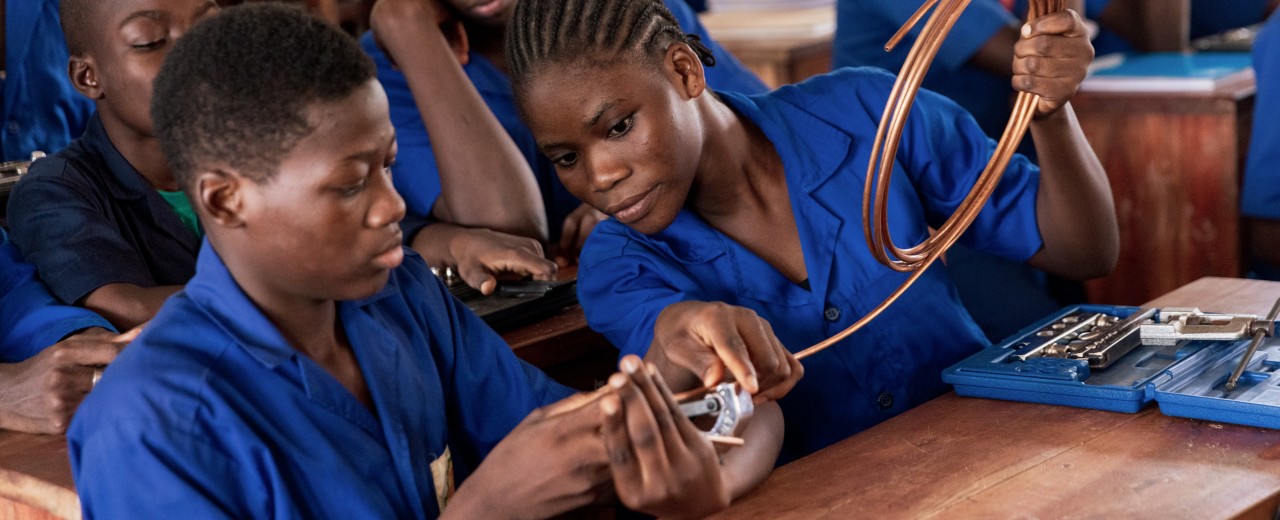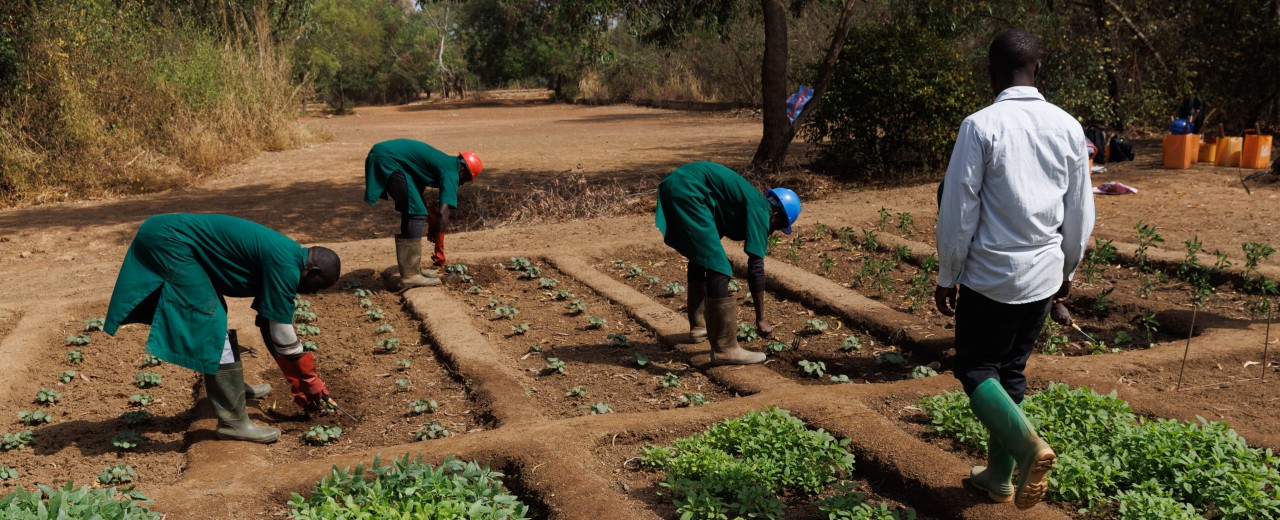Interview with Sara Elder
“The lives of workers are usually very hard”In an interview with Friederike Bauer, Sara Elder, Head of the Employment Analysis and Economic Policy Unit at the ILO, talks about the harsh work reality in developing countries, the underlying reasons and why getting a solid education is still a good idea.

The industrialised countries have. They are more or less back to pre-pandemic levels, in terms of growth and unemployment rates. But that’s not true for all developing countries and emerging economies. Some are experiencing what the ILO calls “lingering scars”, meaning we still see clear traces of the pandemic that don’t seem to go away. In fact, these countries are falling behind, not just in getting unemployment back on track, but they have also made almost no progress in improving the quality of jobs. Stagnant economies since the pandemic have left them struggling to generate the necessary growth that would allow for more formal work and better quality jobs.
Looking at historical trends, strong sustained economic growth of around six percent annually for three to five years is usually needed for a country to leapfrog into the next stage of development and thus create more decent jobs. Most economies are growing again but not to the extent necessary to jump to higher income levels and not at the pace seen prior to COVID-19. Only a few countries are reaching five percent annual growth right now.
Let me answer this by looking at the segment of people that generally present the greatest reasons for concern. Young women are normally hardest hit. Unemployment for them increased more than for young men during the pandemic, and also more young women than men exited the labour force. Plus, it has since been easier for men to re-enter the labour market.
There are many reasons but among them is the damage that comes with having an empty gap in their CVs in the period they were inactive during the pandemic. When they try to find work now, employers move them to the bottom of the queue and instead take a young person emerging directly from school with no gap of inactivity.

They absolutely would. Yet, women have been discriminated against in their labour market access for a long time in many parts of the world, pandemic or no pandemic. This is extremely frustrating because change in overcoming gender gaps is unbearably slow. The statistics say it would take between 100 and 200 years until there is equality in the labour market if we continue at the present pace. In my view there will always be a gender gap; it’s unrealistic to expect that we will ever have perfect equity. And that’s okay as long as the gap is at an acceptable level and reflective of what young women and men want. A participation gap of around 10 percentage points, like in Scandinavian countries, would seem tolerable for me. Yet globally we are nowhere near that.
Correct. The gap is larger in some regions of the world. It usually depends on social norms. That is a big factor, but the support systems provided by the state and employers are also important to encourage women’s employment. One factor that could ease the situation may eventually be aging within the population. The increasing scarcity of workers could push governments to do more to help women overcome the barriers that keep them out of work, and to provide more incentives to draw them in. Childcare provision fits here, for instance.
The lives of workers are usually very harsh in poorer countries, that goes for men and women, even if the latter have more challenges to overcome like getting access to education. If there is money in the family, it always goes to the sons first. That hasn’t changed. People with low income levels tend to have multiple jobs – surviving by “hustling”. They grasp at any work possible to earn a livelihood. And oftentimes they have to migrate to urban areas to follow the jobs, leaving their families and living in harsh conditions to send home whatever money they can.
Most countries in Africa are dealing with all the challenges we already mentioned as they struggle to transform their economies and create decent jobs. On top of this, the region is in the midst of a population boom. Large numbers of young people are trying to enter the labour market every year. So, it’s a difficult combination of factors.

Exactly. The official unemployment rate is actually not that high compared to other regions. It’s around six per cent. But the informal employment rate is more than 80 per cent, which is extremely high. So, many, many people are working under precarious conditions and are poor despite working.
They do. They know that job creation is a challenge and try to make it a policy priority, particularly for young people. The political will is usually there but sometimes governments’ capacity to make the right choices in pursuing job creation strategies is limited. They may tend to prioritise short term gains over what might be needed to overcome long-term structural challenges.
Those in power should try to plan for the long term and invest in the most valuable commodity they have, which is young people. That means putting as much effort as possible into building institutions that provide quality education and training systems. Improving the infrastructure of the country also remains important, including investing in digital infrastructure to spur innovation.
Agriculture is essential, you are right. We see a lot of activity here. Many national and international programmes are active in trying to boost the productivity of agriculture in developing countries and promoting a supply chain approach. So, for instance, farmers are not just growing tomatoes but can also transform the product into a consumer good like tomato paste. There are many interventions in this area, but they tend to be dispersed, not coordinated. At the ILO we always say that to succeed at job creation, governments and social partners need to set employment targets in all policy measures, including in development, investment, macroeconomic and sectoral policies. The pro-employment policy framework requires that all policy mechanisms work together in an integrated manner. Most of the time, this is not the case, not in agriculture policy, but also not in general.

There is a lack of investment, indeed, which is a big oversight. Because the future will be African. The world population will be primarily African by 2050 – this is where our workers will be so it should also be our future centre of production. Africa could transform itself into the breadbasket and the factory floor of the world. My hope is that investment will flow to the continent once this reality becomes clearer.
This is more or less where we are now. And in the meantime, more and more young Africans can get an education. This is great news, and we should applaud the progress here. But on the other hand, there are too few higher-skilled jobs available to absorb all those emerging from the education and training systems. This is common in developing economies. Sometimes it means that the young person has only three options: they can wait for a matching job to appear if they have a family that supports them financially, they can take a job that is below their skill level, or they can migrate somewhere else.
There is always value in getting an education, even if it is just for enhanced life skills and better self-esteem. But it’s true that it might not pay off initially in terms of labour market gains. In the short term, educated youth might face longer or more frequent periods of unemployment or might have to take up jobs that do not meet their expectations. But in the long run, those with higher education still do better in terms of lifetime earnings and access to formal jobs.
New technologies and the green sector both bring new opportunities for job creation. Therefore, we see a lot of countries now trying to promote the growth of such sectors. For the moment, employment in these sectors remains fairly low, but there is still potential. And anyway, the more money that is invested in the green economy, the better for everyone.
Share page
To share the content of this page with your network, click on one of the icons below.
Note on data protection: When you share content, your personal data is transferred to the selected network.
Data protection
Alternatively, you can also copy the short link: https://www.kfw-entwicklungsbank.de/s/enzB4OSP
Copy link Link copied